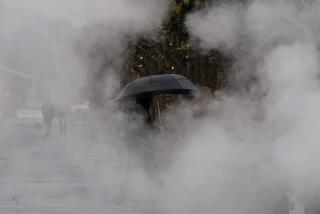Bloomberg unveils sweeping disaster protection plan for New York
- Share via
In a far-reaching plan that would reshape the coastline of the nation’s largest city, New York City Mayor Michael R. Bloomberg unveiled a $20-billion proposal Tuesday that he said will protect New Yorkers from disasters brought on by climate change.
New York’s marriage with the sea has grown more fraught after Superstorm Sandy ravaged the city’s 520-mile coastline.
The sweeping proposal, which could impact the city for years after the mayor’s departure from office in January, calls for a series of new floodwalls, levees, surge barriers and even construction of a new “Seaport City” to protect the East River shoreline.
“This plan is incredibly ambitious -- and much of the work will extend far beyond the next 200 days -- but we refused to pass the responsibility for creating a plan onto the next administration,” Bloomberg said in prepared remarks. “This is urgent work, and it must begin now.”
The specter of climate change and rising waters have loomed over New York more urgently since Sandy wrought an estimated $20 billion in damage along the eastern seaboard.
Reinsurance providers have warned that the northeastern U.S. should expect more frequent flood and hurricane damage as waters rise and weather patterns change.
One Munich RE researcher said earlier this year that taking basic protective steps to adapt would be “absolutely essential,” with another adding that such moves would make economic sense for New York over time. About 400,000 New York residents live in a 100-year flood plain, city officials said.
To support the proposals, Bloomberg has marshaled a small army of experts and a climate-change report that estimates New York City could see its waters rise as much as 31 inches by 2050.
The report also presents worst-case scenarios in which the city gets 15% more precipitation and a 6.5-degree increase in average annual temperature in that time.
More than just beefing up New York’s coastal defenses, the plan also carries a series of political proposals that would redevelop areas hit hardest by Sandy and rewrite the city’s construction codes.
One proposal offers building owners $1.2 billion in grants and loans for flood-resiliency upgrades, and another changes building codes that would require hospitals to adopt 500-year-flood safety standards.
Other proposals would expand emergency-generator coverage and add standards for utility and telecommunications companies to repair service swiftly after outages.
“Millions of New Yorkers lost power during Sandy and hundreds of thousands lost heat, Internet service, or phone service,” Bloomberg said.
“When a crisis hits, when we really need them most, we lose access to them. That is not acceptable,” he said. “Most of these networks are not run or regulated by the city, but the time has come for all of our private-sector partners to step up to the plate and join us in protecting New Yorkers.”
Kevin Burke, chairman and CEO of power provider Con Edison, said in a statement that “Con Edison has already begun making significant investments to protect our infrastructure and our customers from future storms.”
The city will also have to tackle tough new federal flood insurance rates that Bloomberg said would overburden working families in Staten Island.
The 250 recommendations in the new plan -- titled the Special Initiative for Rebuilding and Resiliency -- could use $15 billion in existing city and federal funding that could be driven toward the project, with the city considering various ways to come up with $4.5 billion in additional funds.
Whether all of those proposals will find traction with New Yorkers and federal purseholders is yet to be seen, particularly after Bloomberg leaves office, but the plan presents one of the most ambitious municipal disaster-prevention projects in recent memory.
“We can’t completely climate-proof our city. That would be impossible,” Bloomberg said. “But we can make our city stronger and safer -- and we can start today.”
ALSO:
Princeton University evacuated after bomb threat
Philadelphia collapse survivor: ‘I started running for my life’
George Zimmerman trial: Jury selection grinds into second day
More to Read
Sign up for Essential California
The most important California stories and recommendations in your inbox every morning.
You may occasionally receive promotional content from the Los Angeles Times.











